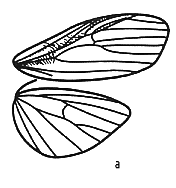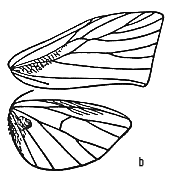|
Teulisna Walker
Type
species: plagiata Walker, Borneo.
Synonyms:
Bitecta Heylaerts (type species: murina
Heylaerts, Java); Corcura Walker
(type species torta Walker, Borneo = chiloides
Walker); Cossa Walker (type species basigera
Walker, India); Diastrophia Felder
(type species dasypyga Felder,
Sulawesi = chiloides Walker); Ityca
Walker (type species humeralis Walker,
Peninsular Malaysia = chiloides Walker);
Lophoneura Hampson (type species uniformis Hampson, Burma) syn. n.; Tegulata Walker (type species tumida
Walker, Borneo).
This
genus embraces a diverse array of species from the Oriental and, with far fewer
species, Australian tropics, many of which have been included in Eilema
Hübner sensu lato in the past. The Bitecta
section, represented below by nigricauda
Holloway and two new species, was reviewed by Holloway (1982). Most species
are sexually dimorphic, particularly with regard to modification of the male
forewing, with brushes of scales arising from the basal part of the costa and
within the cell. Wing shape is variable, including the typical group, treated
first below, with a rather falcate forewing tornus, and the more elongate,
slightly elliptical forewing seen in Bitecta.
The male forewing cell is usually narrowed, with the distal branches tending
to be compressed somewhat into the anterior half of the wing (Fig 2b), and CuA2
having a moderate (typical) to strong (Bitecta; Fig 2a) basal
flexure to bring it into a more posterior position, a feature also seen in the
female.

Fig 2a. Teulisna
murina Heylearts |

Fig 2b: Teulisna
plagiata Walker |
Definitive
features are in the male genitalia: the vinculum is developed into a squarish
frame, indented slightly at the distal margin, that supports a membrane on which
are often diverse setose patches, scent pencils and other structures. These
structures are best developed in the typical group. The saccular process of the
valve has a dense, dark mass of setae or spines apically. The aedeagus vesica
has diverticula that may or may not bear cornuti. The terminal segment of the
abdomen is usually short, sometimes thickened, and with lobes, carinae and some
denser scaling.
The
female genitalia have the bursa immaculate or with a pair of signa.
The
genus is very diverse in Borneo, with a high proportion of the species being
found in montane forests.
<<Back
>>Forward <<Return
to Contents page
|


